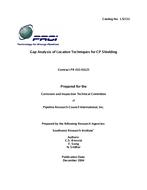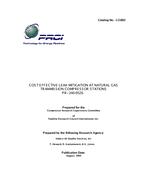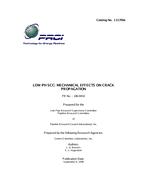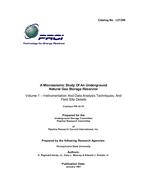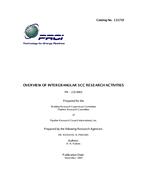Provide PDF Format
PRCI PR-015-03125
- Gap Analysis of Location Techniques for CP Shielding
- Report / Survey by Pipeline Research Council International, 07/01/2004
- Publisher: PRCI
$50.00$99.00
L52131e
Southwest Research Institute
Need: To mitigate and prevent corrosion of pipelines, cathodic protection (CP) is imposed in the form of impressed current, sacrificial anodes (e.g., Mg ribbons), or a combination of the two. To reduce the CP current load and aid in corrosion prevention, most pipelines are also coated with an organic coating. Over the course of time, it has been noted that the coatings tend to degrade leading to disbondments, holidays, and tares. For the most part, the presence of holidays and tares are not of tremendous concern as the CP system is in place to protect them and if needed the current output of the system can be increased to compensate for the formation of new defects. Disbondments, however, can be a source of significant concern because in some case the CP does not penetrate and protect the disbonded region. This has been shown to be a leading factor in enhanced corrosion in the disbonded region as well as in the development of SCC failures in several pipeline systems. Such regions are difficult to protect with CP as they are shielded from the current (i.e., there is insufficient current flow for adequate protection), reflecting a condition known as CP shielding. CP shielding can occur for reasons other than coating disbondments, including permafrost, use of insulating panels to prevent contact of intersecting pipelines, various barrier materials, rocks, tree roots, and other naturally occurring high resistance materials, and often times casings.
Result: Even though not all cases of CP shielding are detrimental, it is evident that detecting and locating possible areas of CP shielding is of prime concern as these locations are potentially subject to higher corrosion rates and possible SCC. The objective of this project was to review and discuss current practices used to detect CP shielding as well as to conduct a gap analysis to explore other promising technologies that may prove useful if implemented. Because there are two main circumstances under which CP shielding is investigated, the discussion centers on detecting CP shielding from above ground and post hole excavations.
Benefit: Based on a review of existing and emerging technologies from the military, aerospace, NDE inspection, and other sensor and detection industries, it is apparent that there are a number of promising methods that can enhance the pipeline industry's ability to detect and locate regions of CP shielding. Many of these, however, are principally focused on detecting coating disbondments rather than CP shielding from other sources.
Southwest Research Institute
Need: To mitigate and prevent corrosion of pipelines, cathodic protection (CP) is imposed in the form of impressed current, sacrificial anodes (e.g., Mg ribbons), or a combination of the two. To reduce the CP current load and aid in corrosion prevention, most pipelines are also coated with an organic coating. Over the course of time, it has been noted that the coatings tend to degrade leading to disbondments, holidays, and tares. For the most part, the presence of holidays and tares are not of tremendous concern as the CP system is in place to protect them and if needed the current output of the system can be increased to compensate for the formation of new defects. Disbondments, however, can be a source of significant concern because in some case the CP does not penetrate and protect the disbonded region. This has been shown to be a leading factor in enhanced corrosion in the disbonded region as well as in the development of SCC failures in several pipeline systems. Such regions are difficult to protect with CP as they are shielded from the current (i.e., there is insufficient current flow for adequate protection), reflecting a condition known as CP shielding. CP shielding can occur for reasons other than coating disbondments, including permafrost, use of insulating panels to prevent contact of intersecting pipelines, various barrier materials, rocks, tree roots, and other naturally occurring high resistance materials, and often times casings.
Result: Even though not all cases of CP shielding are detrimental, it is evident that detecting and locating possible areas of CP shielding is of prime concern as these locations are potentially subject to higher corrosion rates and possible SCC. The objective of this project was to review and discuss current practices used to detect CP shielding as well as to conduct a gap analysis to explore other promising technologies that may prove useful if implemented. Because there are two main circumstances under which CP shielding is investigated, the discussion centers on detecting CP shielding from above ground and post hole excavations.
Benefit: Based on a review of existing and emerging technologies from the military, aerospace, NDE inspection, and other sensor and detection industries, it is apparent that there are a number of promising methods that can enhance the pipeline industry's ability to detect and locate regions of CP shielding. Many of these, however, are principally focused on detecting coating disbondments rather than CP shielding from other sources.
Related Products
PRCI PR-246-9526
Cost Effective Leak Mitigation at Natural Gas Transmission Compressor Stations..
$548.00 $1,095.00
PRCI PR-12-75
A Microseismic Study of an Underground Natural Gas Storage Reservoir Volume 1 - Instrumentation and ..
$198.00 $395.00

